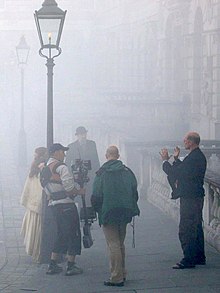Film director

A film director is a person who directs the making of a film.[1] A film director visualizes the script, controlling a film's artistic and dramatic aspects, while guiding the technical crew and actors in the fulfillment of his or her vision.
However, film directors do not always have absolute artistic control. The director is usually selected by the producer, whose job it is to make the decisions that are in the best interests of the production company or studio or network. As such, the producers have veto power over everything from the script itself to the final cut of the film, often in anywhere from slight to extreme opposition to the director's vision.
People such as Anthony Minghella and Paul Greengrass, like Ken Loach and Mike Leigh before them, achieved much of their fame after leaving TV to make films for the big screen. Those directors who choose or are chosen to work in TV traditionally have had to accept that they will not be as lauded, or as well-paid, as their big-screen counterparts.[2]
Responsibilities
A film director is responsible for overseeing every creative aspect of a film. They develop a vision for a film, decide how it should look, what tone it should have, and what an audience should gain from the cinematic experience. They are responsible for hiring a strong, creative team of people to work with production, lighting, cinematography, and costumes. Film directors are responsible for approving every camera angle, lens effect, lighting, and set design. They coordinate the actors moves, determine camera angles, and may be involved in the writing, financing, and editing of a film. The director works closely with the cast and crew. They listen to the cast and crew, take some suggestions, and give out some of their own. They meet with the cast before each scene to do a run through. This tells them how the actors are going to play the scene, which enables them to make changes accordingly.
Methods of film directing
How much control a director exerts over a film varies greatly. Many directors are under the control of the studio and producer. This was true from the 1930s through the 1950s, when studios had many directors, actors and writers under contract.
Meanwhile, other directors have far more control and bring their artistic vision to the pictures they make. Their methods range from those who:
- Outline a general plotline and let the actors improvise dialogue. Two directors who employ this style are Christopher Guest, Spike Lee and occasionally Robert Altman.
- Control every aspect, and demand that the actors and crew follow instructions precisely, or auteurs.
- Write their own scripts (such as Woody Allen, Stanley Kubrick, Charles Chaplin, Billy Wilder, Pedro Almodóvar, Kevin Smith, Quentin Tarantino, Oliver Stone, Hayao Miyazaki, M. Night Shyamalan or Robert Rodriguez).
- Collaborate on screenplays with long-standing writing partners (such as Wes Anderson and Owen Wilson/Noah Baumbach, Martin Scorsese and Nicholas Pileggi/Paul Schrader, Yasujiro Ozu and Kôgo Noda, or Robert Zemeckis and Bob Gale).
- Be the cinematographer and editor (such as Steven Soderbergh, Don Coscarelli, or Robert Rodriguez).
- Appear (often in either leading roles or in minor bit parts) in their films (such as Orson Welles, Zach Braff, Mel Brooks, Mel Gibson, Kevin Costner, Woody Allen, Alfred Hitchcock, Quentin Tarantino, Kevin Smith, M. Night Shyamalan, Harold Ramis, or even Ed Wood, Jr.).
Directors work closely with film producers, who are usually responsible for the non-artistic elements of the film, such as financing, contract negotiation and marketing. Some directors will often take on some of the responsibilities of the producer for their films. Directors like Orson Welles are famously known for writing, directing and producing their films while the early silent film director Alice Guy Blaché not only produced her own pictures, but actually created her own highly successful studio.
Professional organizations
In the United States, directors usually belong to the Directors Guild of America. The Canadian equivalent is the Directors Guild of Canada. A new director might earn as little as $20,000 a year, while the most successful can earn over $500,000 per movie, even millions per film in some cases. [1]
See also
References
- ^ Dictionary Definition
- ^ "Seeing the director's point of view". Financial Times. 2006-08-27.
{{cite news}}: Check date values in:|date=(help)
